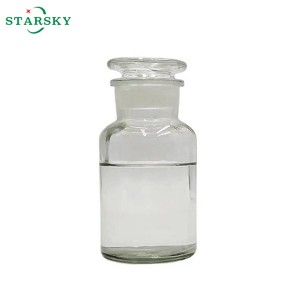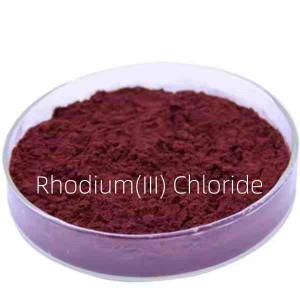N-Methylformamide/cas 123-39-7/NMF
Product name:N-Methylformamide/NMF
CAS:123-39-7
MF:C2H5NO
MW:59.07
Density:1.011 g/ml
Melting point:-3.2°C
Boiling point:198-199°C
Package:1 L/bottle, 25 L/drum, 200 L/drum
Property:It is mutually soluble with benzene, soluble in water and alcohol, insoluble in ether.
1.It is used in the synthesis of pesticide insecticide and acaricide monometamidine and bimetamidine.
2.It is also used in the production of medicine, synthetic leather, artificial leather and chemical fiber textile solvent.
1. Solvent: NMF is commonly used as a solvent in chemical reactions and processes due to its ability to dissolve a wide range of organic and inorganic compounds.
2. Chemical intermediate: It is an intermediate in the synthesis of various chemicals including pharmaceuticals and agrochemicals.
3. Plasticizer: NMF can be used as a plasticizer in the production of plastics and polymers to enhance their flexibility and processability.
4. Electrolyte: Due to its ionic conductivity, it is used as an electrolyte in certain battery applications.
5. Extraction agent: NMF is used in the extraction process, especially for the extraction of certain metals and organic compounds.
6. Research: In the laboratory, NMF is used for a variety of research applications, including those involving organic synthesis and materials science.
Sealed storage to prevent leakage, avoid rain, exposure, severe impact and friction.
Keep away from fire and heat sources.
1. Container: Use airtight containers made of compatible materials, such as glass or certain plastics, to prevent contamination and evaporation.
2. Temperature: Store NMF in a cool, dry place away from direct sunlight and heat. Ideally, it should be kept at room temperature, but avoid exposure to extreme temperatures.
3. Ventilation: Ensure storage areas are well ventilated to minimize vapor buildup as NMF can emit hazardous fumes.
4. Incompatibility: Please keep NMF away from strong oxidants, acids and bases as it may react with these substances.
5. Label: Clearly label containers with chemical name, hazard information, and receipt date to ensure proper handling and identification.
6. Personal Protective Equipment (PPE): When handling NMF, use appropriate PPE such as gloves and goggles to minimize exposure.
7. Disposal: Dispose of NMF and any contaminated materials in compliance with local regulations.

1. Colorless transparent viscous oily liquid.
It is soluble in water and can also dissolve inorganic salts.
It is hygroscopic and easily decomposes in acidic or alkaline solutions.
It smells of ammonia.
The chemical properties interact with hydrogen chloride to form two kinds of salts;
HCONHCH3·HCl is produced in non-polar solvents;
(HCONHCH3)2·HCl is produced without solvents.
It has almost no effect with sodium metal at room temperature.
Hydrolysis occurs under the action of acid or alkali.
The acidic hydrolysis rate is formamide>N-methylformamide>N,N-dimethylformamide.
The alkaline hydrolysis rate is formamide-N-methylformamide>N,N-dimethylformamide.
2. Exist in mainstream smoke.
1. Regulatory Compliance: Ensure you comply with local, national, and international regulations regarding the transportation of dangerous goods. NMF is classified as a hazardous material and therefore may be subject to specific shipping regulations (e.g., UN number, proper shipping name).
2. Packaging: Use appropriate packaging materials that are compatible with NMF. Typically, this includes chemically resistant, leak-proof containers. Ensure containers are securely sealed to prevent leakage during transport.
3. Label: Clearly label packaging with the correct hazard symbols and information, including the correct shipping name, UN number and any relevant hazard warnings. This helps ensure that handlers understand the contents of the cargo and the associated risks.
4. Documentation: Prepare and attach all necessary shipping documentation, such as Material Safety Data Sheets (MSDS) and any required hazardous materials declarations.
5. Temperature Control: If necessary, consider implementing temperature control measures during transportation to prevent exposure to extreme temperatures that could affect product integrity.
6. Training: Ensure that personnel involved in the transportation process are trained in handling dangerous goods and understand the risks associated with NMF.
7. Emergency Procedures: Have emergency response procedures in place in case of spills or leaks during transport. This includes having a spill kit and appropriate personal protective equipment (PPE) ready.
8. Transportation method: Choose a reliable, compliant transportation service that has experience handling dangerous goods.

1. Inhalation: Exposure to NMF vapors can irritate the respiratory tract, causing symptoms such as coughing, shortness of breath, and throat irritation. Prolonged or high-intensity exposure may cause more serious respiratory problems.
2. SKIN CONTACT: NMF can cause skin irritation and may be absorbed through the skin, which may result in systemic effects. It is recommended to wear protective gloves when handling this material.
3. Eye Contact: Contact with NMF can cause eye irritation, resulting in redness, pain, and possible damage to the eyes.
4. Ingestion: Ingestion of NMF may be harmful and may cause gastrointestinal irritation, nausea, vomiting, and other serious health effects.
5. Long-term effects: Long-term exposure to NMF may produce reproductive and developmental toxicity. Some studies have shown that it may have adverse effects on fertility and fetal development.
6. Safety Precautions: To minimize risk, always use appropriate personal protective equipment (PPE) such as gloves, goggles, and respiratory protection when handling NMF. Ensure that the work area is well ventilated.
7. Emergency Measures: In case of contact, seek medical attention immediately and take appropriate first aid measures, such as flushing the affected area with water and removing contaminated clothing.











